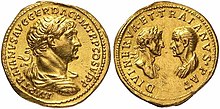
Hadrian was Roman emperor from 117 to 138. Hadrian was born in Italica, close to modern Seville in Spain, an Italic settlement in Hispania Baetica; his branch of the Aelia gens, the Aeli Hadriani, came from the town of Hadria in eastern Italy. He was a member of the Nerva-Antonine dynasty.
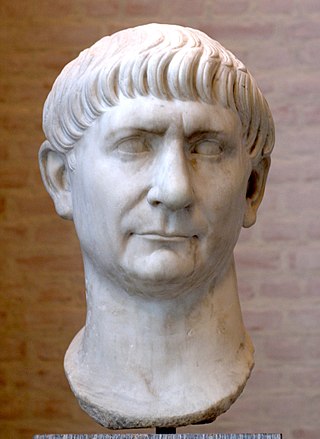
Trajan was Roman emperor from AD 98 to 117, the second of the Five Good Emperors of the Nerva–Antonine dynasty. He was a philanthropic ruler and a successful soldier-emperor who led the Roman Empire to its greatest territorial extent by the time of his death. He was given the title of optimus by the Roman Senate.

Adoption in ancient Rome was primarily a legal procedure for transferring paternal power (potestas) to ensure succession in the male line within Roman patriarchal society. The Latin word adoptio refers broadly to "adoption", which was of two kinds: the transferral of potestas over a free person from one head of household to another; and adrogatio, when the adoptee had been acting sui iuris as a legal adult but assumed the status of unemancipated son for purposes of inheritance. Adoptio was a longstanding part of Roman family law pertaining to paternal responsibilities such as perpetuating the value of the family estate and ancestral rites (sacra), which were concerns of the property-owning classes and cultural elite. During the Imperial era, adoption became a way to ensure imperial succession.

Pannonia Inferior, lit. Lower Pannonia, was a province of the Roman Empire. Its capital was Sirmium. It was one of the border provinces on the Danube. It was formed in the year 103 AD by Emperor Trajan who divided the former province of Pannonia into two parts: Pannonia Superior and Pannonia Inferior. The province included parts of present-day states of Hungary, Serbia, Croatia, and Bosnia and Herzegovina. The province was bordered to the east by a Sarmatian tribe—the Iazyges. Later, the Vandals appeared to the north-east.

Salonia Matidia was the daughter and only child of Ulpia Marciana and wealthy praetor Gaius Salonius Matidius Patruinus. Her maternal uncle was the Roman emperor Trajan. Trajan had no children and treated her like his daughter. Her father died in 78 and Matidia went with her mother to live with Trajan and his wife, Pompeia Plotina.

Ulpia Marciana was the beloved elder sister of Roman Emperor Trajan and grandmother of empress Vibia Sabina the wife of Hadrian. Upon her death, her brother had her deified.

Pompeia Plotina was Roman empress from 98 to 117 as the wife of Trajan. She was renowned for her interest in philosophy, and her virtue, dignity and simplicity. She was particularly devoted to the Epicurean philosophical school in Athens, Greece. She is often viewed as having provided Romans with fairer taxation, improved education, assisted the poor, and created tolerance in Roman society.
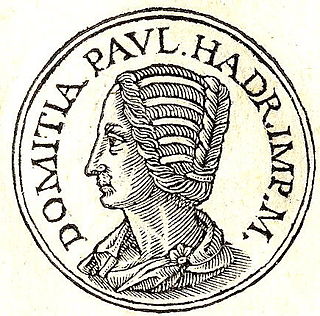
Paulina or Paullina is a common female given name Latin. In Greek it means: Paulina was a name shared by three relatives of the Roman Emperor Hadrian: his mother, his elder sister and his niece.

Marcus Ulpius Traianus was a Roman senator and the father of Emperor Trajan.

Mindia Matidia, also known as Matidia Minor was a Roman imperial noblewoman in the early second century AD. She was related to several ancient Roman Emperors, as a great-niece to Trajan and half-sister to Vibia Sabina, who was the wife of Hadrian. The modern village of Matigge, Italy, is perhaps named after her.

Publius Aelius Hadrianus Afer was a distinguished and wealthy Roman senator and soldier who lived in the Roman Empire during the 1st century. Hadrianus Afer was originally from Hispania and was of Roman descent. He was born and raised in the city of Italica in the Roman province of Hispania Baetica. He came from a well-established, wealthy and aristocratic family of Praetorian rank. He was the son of the noble Roman woman Ulpia and his father was the Roman senator, Publius Aelius Hadrianus Marullinus. Hadrianus Afer's maternal uncle was the Roman general and senator Marcus Ulpius Traianus, the father of Ulpia Marciana and her younger brother Emperor Trajan. Ulpia Marciana and Trajan were his maternal cousins.
Publius Acilius Attianus was a powerful Roman official who played a significant, though obscured, role in the transfer of power from Trajan to Hadrian.
The gens Aelia, occasionally written Ailia, was a plebeian family in Rome, which flourished from the fifth century BC until at least the third century AD, a period of nearly eight hundred years. The archaic spelling Ailia is found on coins, but must not be confused with Allia, which is a distinct gens. The first member of the family to obtain the consulship was Publius Aelius Paetus in 337 BC.
Marcia was an ancient Roman noblewoman and the mother of the emperor Trajan.
Gaius Salonius Matidius Patruinus was a Roman Senator who lived in the Roman Empire during the 1st century during the reign of Vespasian.
Lucius Vibius Sabinus was a Roman Senator who lived in the 1st century. His daughter Vibia Sabina married the emperor Hadrian.
Publius Aelius Hadrianus Marullinus, also known as Aelius Hadrianus Marullinus or Aelius Marullinus, was a Roman Senator of Praetorian rank from Hispania who lived in the Roman Empire during the 1st century.
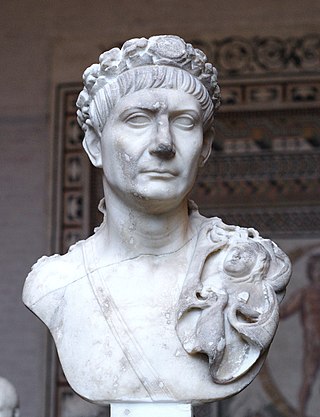
The gens Ulpia was a Roman family that rose to prominence during the first century AD. The gens is best known from the emperor Marcus Ulpius Trajanus, who reigned from AD 98 to 117. The Thirtieth Legion took its name, Ulpia, in his honor. The city of Serdica, modern day Sofia, was renamed as Ulpia Serdica.
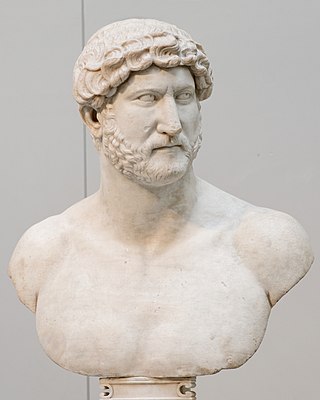
A bust of Hadrian, the second-century Roman emperor who rebuilt the Pantheon and constructed the Temple of Venus and Roma, was formerly displayed in Pope Sixtus V's Villa Montalto and is now displayed at the British Museum in London. The bust is one of the Townley Marbles collected by Charles Townley (1737–1805) and sold by his heir Peregrine Edward Towneley at a reduced price to the British Museum in 1805. Unlike most busts of Hadrian and other emperors, it shows him in heroic nudity. The bust was found in Rome and is carved from Greek marble.
